Valve Corporation Bundle
How Does Valve Dominate the Gaming World?
Valve Corporation, a titan in the video game industry, revolutionized how we experience games. From its humble beginnings creating iconic titles like the Half-Life series, Valve has consistently pushed boundaries. But how did this game developer transform into a digital distribution powerhouse, changing the Valve Corporation SWOT Analysis?
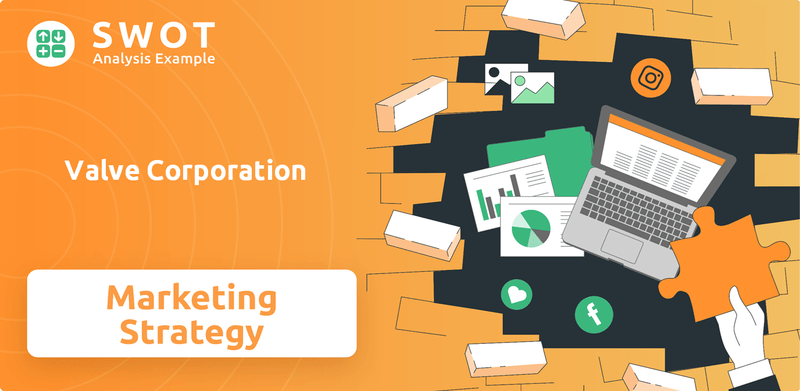
This exploration delves into Valve's innovative sales and marketing strategies, dissecting its evolution from a traditional game developer to a platform-centric business. We'll analyze the impact of the Steam platform on Valve's sales tactics, examining its customer acquisition strategy and how it leverages community engagement. Understanding Valve's approach provides valuable insights into the video game industry and its competitive landscape.
How Does Valve Corporation Reach Its Customers?
The core of the Valve Corporation business model revolves around its sales channels, primarily through its digital distribution platform, Steam. This platform has become synonymous with PC gaming, holding a dominant position in the market. Valve's strategic approach to sales channels has been pivotal in its success within the video game industry.
Steam serves as an e-commerce hub where users can purchase, download, and manage their game libraries. The platform's evolution has been continuous, with regular updates and new features designed to enhance user experience and provide developers with robust tools. This direct-to-consumer (DTC) model allows Valve to maintain control over its distribution and customer relationships.
Valve's sales strategy is not limited to its own games; it also facilitates sales for a vast array of third-party game developers and publishers. This comprehensive approach has solidified Steam's position as the leading platform for PC game distribution, generating substantial revenue through commissions.
Steam's market share in the PC game distribution market exceeded 75% in 2024, showcasing its significant influence. The platform's user base is substantial, with over 132 million monthly active users as of 2024. This large user base provides a vast audience for both Valve's games and those of third-party developers.
Valve is expanding its ecosystem through strategic partnerships, such as providing SteamOS to third-party hardware manufacturers. At CES 2025, Lenovo showcased its Legion Go, the first third-party device to feature SteamOS. This move indicates a broader hardware integration strategy.
Valve's hardware sales, particularly the Steam Deck, also contribute to its sales channels. The Steam Deck, which runs on SteamOS, has boosted Linux gaming on the platform, reaching 2.69% of Steam users in May 2025. This hardware integration complements the digital distribution strategy.
Valve generates substantial revenue through commissions from third-party game sales on Steam. In 2024, these commissions generated over $3 billion. This revenue stream is a key component of Valve's financial success and supports its ongoing investments in platform development and game creation.
Valve's sales tactics for Steam games are multifaceted, focusing on platform features, strategic partnerships, and hardware integration. These tactics contribute to the company's competitive advantage in marketing and sales within the video game industry.
- Continuous platform improvements to enhance user experience and developer tools.
- Partnerships to expand the ecosystem and increase market reach.
- Hardware sales, such as the Steam Deck, to drive platform adoption and revenue.
- Commission-based revenue from third-party game sales, creating a diverse income stream.
Valve Corporation SWOT Analysis
- Complete SWOT Breakdown
- Fully Customizable
- Editable in Excel & Word
- Professional Formatting
- Investor-Ready Format
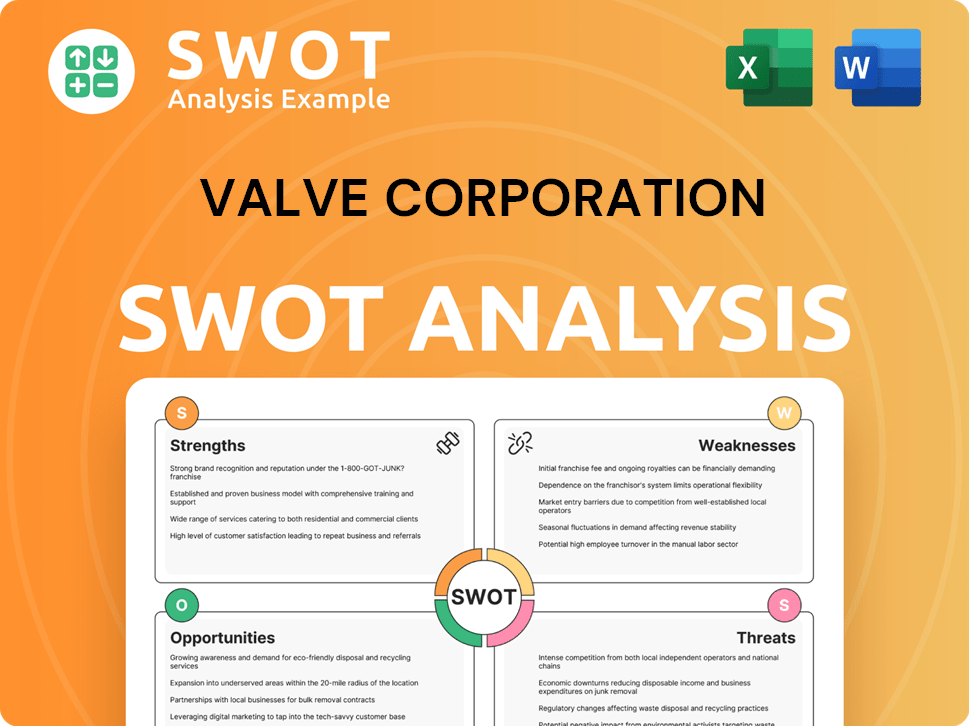
What Marketing Tactics Does Valve Corporation Use?
The marketing tactics employed by Valve Corporation, a prominent player in the video game industry, are heavily centered on digital strategies, community engagement, and user-generated content. This approach often steers clear of aggressive traditional marketing methods. A core element of their strategy revolves around leveraging the robust features of the Steam platform to boost awareness and drive sales.
Valve's approach to marketing is deeply rooted in data analysis, utilizing the extensive user data available on Steam. This enables personalized recommendations and content optimization. Furthermore, the company's sales events on Steam function as significant marketing tools, driving substantial engagement and purchases. This includes major seasonal sales and themed fests throughout the year.
Valve's marketing strategy also encompasses supporting game developers, which indirectly serves as a marketing tactic for the platform itself. This includes new demo rules allowing developers to notify wishlisters when a demo is launched, leading to increased exposure and wishlists. The integration of AI into marketing workflows is a growing trend, with hyper-personalization and predictive modeling being key for 2025, enabling businesses to anticipate customer needs and tailor experiences.
Valve heavily relies on Steam's features to build awareness and drive sales. This includes frequent platform updates and fostering community through discussions and reviews. This is a key aspect of their Valve sales strategy.
Valve uses extensive user data on Steam for personalized recommendations and content optimization. This data-driven approach enhances user experience and drives sales. This is a critical element of their Valve marketing strategy.
Sales events on Steam, such as seasonal and themed fests, are a significant marketing tool. These events generate substantial engagement and drive purchases. Revenue during seasonal sales grew by 10% year-over-year in 2024.
Valve supports game developers, which indirectly markets the platform. New demo rules and curated featuring for Steam Sales benefit developers. This strategy enhances their Valve Corporation business model.
The integration of AI into marketing workflows is a growing trend, with hyper-personalization and predictive modeling being key for 2025. This enables businesses to anticipate customer needs and tailor experiences.
Valve fosters a sense of community through discussions and user reviews. Empowering users to create and share content is also a key aspect of their strategy. This approach enhances the Valve games experience.
Valve's approach to marketing is multifaceted, focusing on digital distribution and community engagement. The company’s ability to leverage the Steam platform and support game developers is crucial to its success. For a deeper dive into Valve's overall strategic approach, consider exploring the Growth Strategy of Valve Corporation.
Valve Corporation PESTLE Analysis
- Covers All 6 PESTLE Categories
- No Research Needed – Save Hours of Work
- Built by Experts, Trusted by Consultants
- Instant Download, Ready to Use
- 100% Editable, Fully Customizable
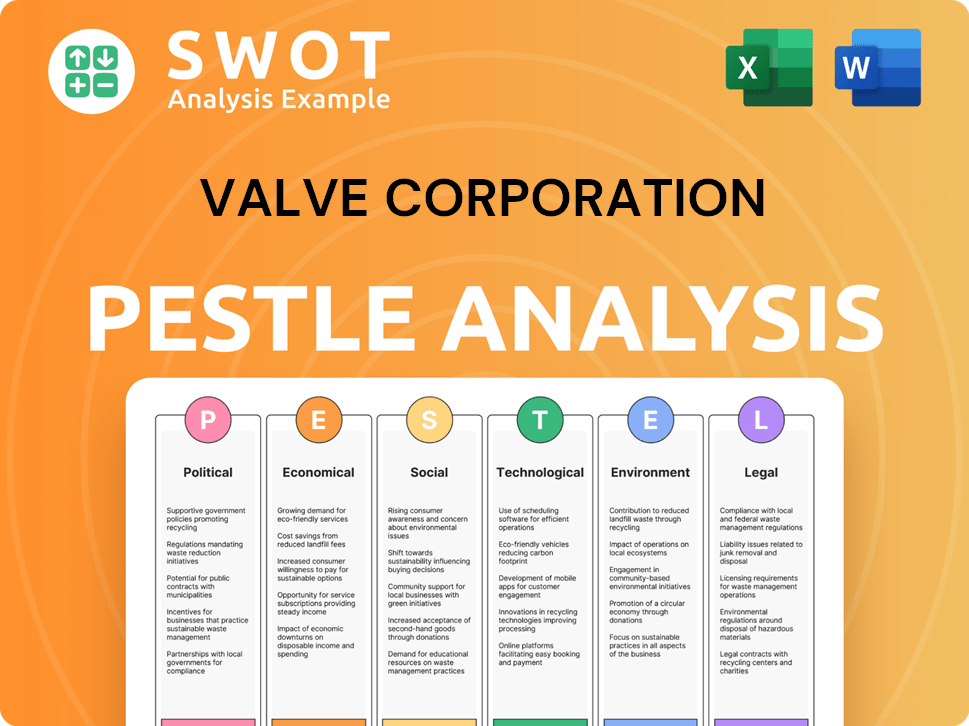
How Is Valve Corporation Positioned in the Market?
Valve Corporation has built a strong brand identity centered on innovation, quality, and community engagement. Their approach differentiates them from competitors by prioritizing a user-centric experience and a commitment to high-quality game development over simply releasing a large quantity of games. This strategy has allowed Valve to cultivate a loyal fanbase within the video game industry.
The core message of Valve revolves around providing an extensive and engaging gaming ecosystem primarily through Steam, which offers more than just a storefront. Steam provides social features, game discovery tools, and features that enhance the gaming experience. This comprehensive approach appeals to PC gamers and developers, fostering an environment where user-generated content and community feedback are highly valued.
Valve's brand identity is reinforced through a consistent visual style and tone of voice that is understated and developer-focused. This reinforces its image as a company that understands and caters to the gaming community. The company's success is evident in the dominance of its Steam platform, which held over 75% of the PC game distribution market in 2024, showcasing its strong brand recognition and trust within the industry. For a deeper understanding, you can explore the Brief History of Valve Corporation.
Valve prioritizes the user experience, creating a platform and games that cater to player needs and preferences. This focus helps build a strong and loyal community.
Valve actively involves the community through user-generated content, feedback, and social features on Steam. This approach fosters a sense of belonging and drives sales.
Valve focuses on developing high-quality games, which enhances brand reputation and player satisfaction. This approach helps in long-term customer retention.
Steam serves as the central hub, offering a comprehensive gaming ecosystem that includes a storefront, social features, and game discovery tools, all contributing to a strong brand identity.
Valve is known for its innovative approach to game development, consistently pushing boundaries in the industry. This includes advancements in game engines and gameplay mechanics.
Valve's digital distribution strategy, primarily through Steam, has been a key factor in its success. This allows for direct sales, updates, and community interactions.
Valve has been actively involved in the VR market, which is projected to reach $57.21 billion by 2025. This expansion demonstrates their commitment to emerging technologies.
Valve's marketing campaigns are often understated, focusing on community engagement and word-of-mouth. This approach is effective in reaching their target audience.
Valve employs various sales tactics on Steam, including discounts, bundles, and seasonal promotions, to drive sales and engage players. This helps in increasing revenue.
Valve's competitive advantage lies in its user-centric approach, strong community, and innovative game development. This allows them to maintain a leading position in the industry.
Valve Corporation Business Model Canvas
- Complete 9-Block Business Model Canvas
- Effortlessly Communicate Your Business Strategy
- Investor-Ready BMC Format
- 100% Editable and Customizable
- Clear and Structured Layout
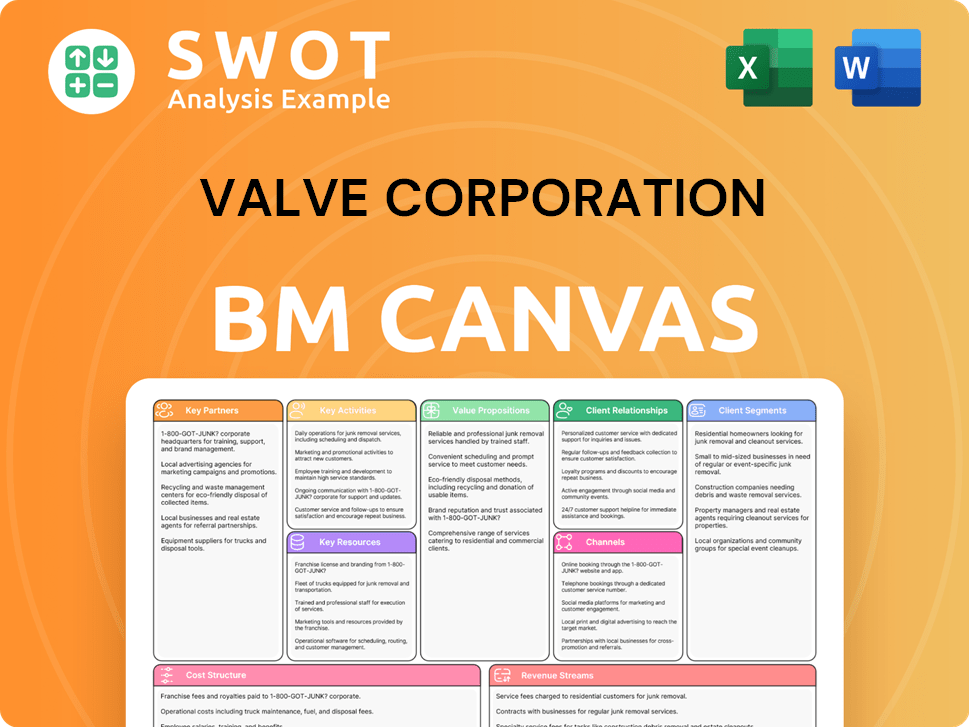
What Are Valve Corporation’s Most Notable Campaigns?
The sales and marketing approach of Valve Corporation focuses on the Steam platform and community-driven initiatives rather than traditional campaigns. A significant aspect of their strategy involves the consistent evolution and promotion of Steam. In 2024, Steam experienced its most successful year to date in terms of users purchasing newly released games.
A key component of Valve's ongoing Valve sales strategy is the implementation of seasonal sales and themed events. These events, such as the Steam Summer Sale and Winter Sale, are designed to drive significant sales volume by offering substantial discounts, encouraging users to expand their game libraries. Revenue during these seasonal sales saw a 10% year-over-year increase in 2024.
Furthermore, the continuous development and promotion of the Steam Deck, Valve's handheld gaming console, also plays a crucial role. This product has substantially contributed to the growth of Linux gaming on Steam. The Steam platform ecosystem is also expanding through new hardware innovations, like a wireless VR headset and a living room console named 'Fremont.'
The consistent promotion and evolution of the Steam platform is a core Valve marketing strategy. Steam's ongoing development ensures a robust and engaging user experience. This includes updates, features, and community tools that enhance game discovery and player interaction.
Seasonal sales, such as the Summer and Winter Sales, are major events driving sales. These sales offer significant discounts, encouraging users to expand their game libraries. Revenue during these sales grew by 10% year-over-year in 2024.
The Steam Deck is another key component of Valve's sales and marketing efforts. It significantly contributes to the growth of Linux gaming on Steam. Linux usage among Steam users increased to 2.69% in May 2025.
Valve is expanding its hardware presence with new innovations, such as a wireless VR headset and a living room console. These hardware initiatives aim to expand the Steam ecosystem. This strategy attracts new users and enhances the gaming experience.
Valve's strategy emphasizes community engagement through platform features, events, and user-generated content. These elements create a loyal user base. Valve's approach is a key factor in its success within the video game industry.
- Active forums and discussion boards.
- User-generated content and modding support.
- Regular updates and improvements based on user feedback.
- Community events and contests.
Valve's approach to sales and marketing is unique. Their strategies, from platform development to hardware expansion, are designed to enhance the gaming experience. For more insights into the company's competitive environment, consider exploring the Competitors Landscape of Valve Corporation.
Valve Corporation Porter's Five Forces Analysis
- Covers All 5 Competitive Forces in Detail
- Structured for Consultants, Students, and Founders
- 100% Editable in Microsoft Word & Excel
- Instant Digital Download – Use Immediately
- Compatible with Mac & PC – Fully Unlocked
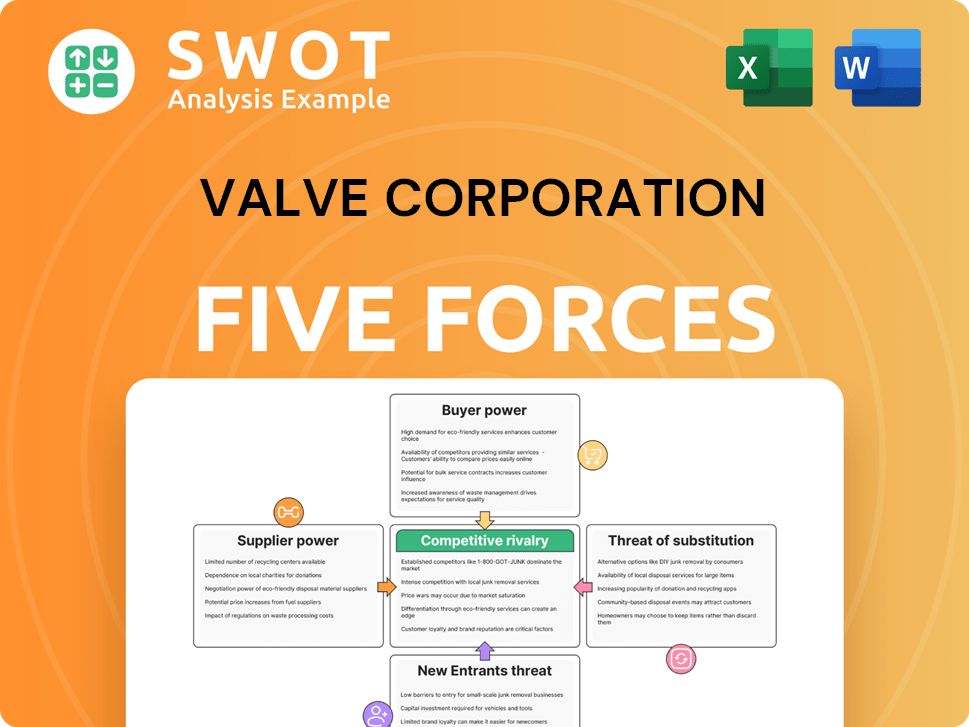
Related Blogs
- What are Mission Vision & Core Values of Valve Corporation Company?
- What is Competitive Landscape of Valve Corporation Company?
- What is Growth Strategy and Future Prospects of Valve Corporation Company?
- How Does Valve Corporation Company Work?
- What is Brief History of Valve Corporation Company?
- Who Owns Valve Corporation Company?
- What is Customer Demographics and Target Market of Valve Corporation Company?
Disclaimer
All information, articles, and product details provided on this website are for general informational and educational purposes only. We do not claim any ownership over, nor do we intend to infringe upon, any trademarks, copyrights, logos, brand names, or other intellectual property mentioned or depicted on this site. Such intellectual property remains the property of its respective owners, and any references here are made solely for identification or informational purposes, without implying any affiliation, endorsement, or partnership.
We make no representations or warranties, express or implied, regarding the accuracy, completeness, or suitability of any content or products presented. Nothing on this website should be construed as legal, tax, investment, financial, medical, or other professional advice. In addition, no part of this site—including articles or product references—constitutes a solicitation, recommendation, endorsement, advertisement, or offer to buy or sell any securities, franchises, or other financial instruments, particularly in jurisdictions where such activity would be unlawful.
All content is of a general nature and may not address the specific circumstances of any individual or entity. It is not a substitute for professional advice or services. Any actions you take based on the information provided here are strictly at your own risk. You accept full responsibility for any decisions or outcomes arising from your use of this website and agree to release us from any liability in connection with your use of, or reliance upon, the content or products found herein.